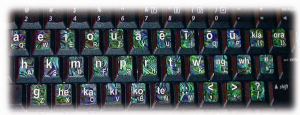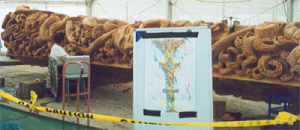Weblog #3
1st Post: The Postmodern Condition: A Report On Knowledge
Lyotard outlines the historic grand narratives of the great nations and how these myths of perfection, liberation and unity of all knowledges has devalued and marginalized knowledges that have traditionally lied outside these grand unifying narratives. But he perceives that a new age is dawning in our postmodern world in which technology and dissolution of boundaries are enabling new forms of interaction and communication of ideas. No longer do we rely on state, church or institutions for knowledge, but rather technology and cybernetics are creating greater skepticism of these traditional legitimization myths of knowledge. And cybernetics is allowing new interactions to form in which knowledges can be nurtured in small institutions or patches. These patches provide safe places for people to share, explore and evolve specific world views and knowledges separate from the sanctions of state and “expert”. In addition, it also allows people to belong to multiple patches in which knowledges can be shared and new ideas can evolve from interactions between these world views. Although Lyotard is an optimist, he does warn that the internet is not all rosy and there are issues such as copyright law, ownership, and reductionism in the quest for optimization (idea of borrowing certain ideas out of context in the effort to evolve towards ONE ultimate optimized unifying ideal). Lyotard`s optimism and pessimism for the future of our postmodern world informs the evolution of Indigenous peoples interactions in cybernetic space and their creation of virtual communities and utilization of interfaces. The internet provides opportunities for Indigenous people to legitimize and share their knowledges within a public sphere, thereby shedding the mantle of the marginalized, however, it also contains the risk that knowledges will be stolen and perverted in the pursuit of one unifying ideal for optimization.
In this article, Wendy Russel, from Huron University College, studied the forty-five individual First Nation settlements in the Nishnawbe-Aski Territory of Northern Ontario, Canada. She found that although isolated from transportation networks, it has increasing economic and political links to government, companies and media. This provides unique challenges to these “place-based” communities who have existed in relative autonomy from outside interference up until now. But with the modern advancements in informational technology and globalization, new power struggles are evolving that reflect residual colonization directives. Traditional claims to territory are in competition with other “communities” claims such as resource companies. With the rise of non-placed based virtual communities, including environmental groups, mining companies and international Indigenous solidarity organizations, there results a new power struggle for control over people and territory. These communities are constantly evolving and complete for legitimacy with each other, often challenging the rights or autonomy of the people actually living on the land. Because of this continued threat of colonization of Indigenous people due to globalization and evolving definition of community, a central role of her research is to investigate how people excluded from virtual community both sustain and re-embed community within place.
3rd Post: Twentieth-century Transformations of East Cree Spirituality and Autonomy
Richard Preston’s research considers what happens to Indigenous people that move from place-based territories, in which they have practiced land-based spirituality, into towns. Of particular interest to me, was his reference to the political autonomy of the Cree. Political autonomy, as practiced by nation states, includes negotiation of collective distinctiveness, a process that leaves little room for negotiation and authentic identity of individuals. But this political autonomy also gives legitimacy and boundary separation enabling the strong pursuit of rights and autonomy as a unified group. However, if this political sense of autonomy becomes part of the “formation and nurturing” of community, it risks excluding or alienating community members that do not fit within this definition of collective distinctiveness.
“The type of autonomy that is congenial to individuals, or more accurately, to personal communities, is based on inclusion rather than exclusion. In families, or in marriages, or in larger personal communities, autonomy of the type that evidences a shared ethos based on sustained responsible, respectful decisions and actions is successful, where exclusionary and power seeking autonomy is destructive. “
4th Post: A Cyborg Manifesto: Science, Technology, and Socialist-Feminism in the Late Twentieth Century
There are two reasons why I have included this article in my posts: Donna Haraway presents a warning about autonomy and distinctiveness within communities which I plan to include in my final project, and another one of my peers indicated a love for her and her teachings in one of the posts in which I mentioned her regarding Indigenous issues.
Although a feminist theoretical document, the feminist word throughout the document can be removed and reinserted with the word marginalized or Indigenous. Ultimately, her article is a manifesto for the marginalized in which political distinctiveness has led to some disastrous consequences. She declared that the way in which we assert rights and delineate communities can have profound effects on its members often alienating small patches within communities and delegitimatizing individuals. She points out that humans are often forced to live in systems of standardization that they don`t fit, but have to live with. For instance, black women have often been denied a voice in the black movement and in the women`s movement. The black movement is controlled and defined by black men and the women`s movement is defined by white affluent women leaving black women without a voice. Similarly, many communities within different Indigenous territories are all lumped in together and are defined by the powerful or the majority, leaving small collectives or individuals, on the boundaries, alienated and excluded. This is similar to the colonization process that was experienced by the Indigenous as the other. And it is this process of delineation and declaration of boundaries, required by the mainstreamers to acquire autonomy, rights and power, that further colonize their own subset of marginalized individuals. The abused run the risk of becoming the abusers in the pursuit of power and self-determination as a group. As Indigenous people become part of a globalized world in which communities become virtual rather than place-based, these definitions and boundaries may become more or less pronounced depending on socio-political circumstances, but also on choices made by the communities themselves. Through the awareness of the past and future pitfalls, Indigenous people may be in a better place to make these crucial decisions about their community`s evolution.
5th post: Is It Possible To Have Information Technology That Reflects Indigenous Consciousness?
In this 2007 article, the participants at the Chaco Canyon encampment, including the Indigenous Polynesian, Lakota, Navajo, Cherokee, Tuscarora, Japanese-American and Euro-American scholars, computer scientists, artists and educators share their trans-cultural view of technology and answer the question: Is it possible to develop Information Technology that reflects Indigenous Consciousness? In this investigation, some of the questions they looked at included:
- “What is Indigenous consciousness?”
- “What are the characteristics distinct to Indigenous technologies?”
- “How do different aspects of information technology integrate into conscious, animate systems, which support the community?”
- “What is an appropriate interface with digital technology?”
For thousands of years, Indigenous people have adapted and evolved to their environment, and like the past, they will continue to evolve as they explore the “potentiality of all things before we begin to put limits on it.” For instance, technologies that fit within the Indigenous consciousness include the Hakamana Maori Keyboard System, that respects the cultural and language needs of Indigenous peoples or “small collectives” by using intuitive keys made of paua shells (meaningful to the Maori)
Appropriate interfaces with digital technologies would include the digital brush system that could interact with Indigenous artifacts and provide a new digital dimension to “knowledge holding”.
Pou Kapua , the cloud pillar in Auckland, New Zealand holds the spirits and stories of the Maori people.


I/O Brush – http://web.media.mit.edu/~kimiko/iobrush/
Other appropriate interfaces include those that incorporate the traditions of oral storytelling and create immersive environments and multisensory experiences such as immersive environments.

Ashes and Snow (www.ashesandsnow.com) creates an immersive environment that incorporates the movement of the mouse on the screen enabling a melding the physical and intuitive senses creating a holistic experience.
Von Thater-Braan, R. (2007). Is it possible to have Information Technology that reflects Indigenous Consciousness? Retrieved from http://silverbuffalo.org/IT4IndigenousConsciousness.pdf



0 comments
Kick things off by filling out the form below.
You must log in to post a comment.